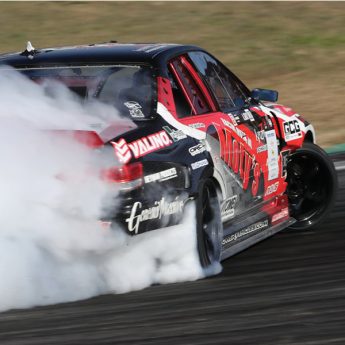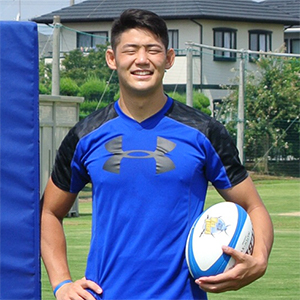
Focus is key for the short knockout confrontations.
The Robinsons have travelled from the UK to Ohama Sumo Park in Sakai City to test their mettle in the 20th Sumo World Championships; the showcase competition on the global amateur sumo calendar. BCCJ ACUMEN visited them on the day before their competition, as they settled in after a long-haul flight, and prepared for competition the following day.
Mike, who runs an engineering firm in Doncaster, South Yorkshire, weighs in at 160kg. Visually, to a layman, he has the characteristic sumo shape and mass—a powerful combination of fat and muscle. He has two years of sumo experience under his belt or, more accurately, his mawashi, the famous loincloth that costs around £200.
So, what has driven him and his son to fly 9,000km to this arena?
“It is the fact that, at 48-years-old, you have the chance to represent your country—and it is an entertaining sport”, he said. “The camaraderie is good, and we enjoy the travels abroad”.
Brad—of fighting weight 114kg—is 21, which is young for a sumo athlete. But Mike believes that he has the potential to be world champion in the future. Events like the Osaka competition are perfect, he said, for training and developing skills.
Sumo matches are a series of knockout confrontations that last a matter of moments, typically between five and 10 seconds.
“It is very unpredictable”, said Brad, who works at his father’s firm. “There was a guy in the Netherlands team who went to North America and beat everybody there; he didn’t lose once. Then he came up against me in Italy, and lost—and I had only been doing sumo for about a year.
“You have got 90 minutes to play rugby, you have 90 minutes to make up if you make a mistake. With this, you have seconds, and you might be out”, he added.
Mike refers to their sport as a hobby. Intercontinental flights and accommodation can be expensive, but the Robinsons benefit from some sponsorship support from their firm’s customers and suppliers.
To win a sumo competition like this, Mike explained, an athlete would need to win five rounds. Today, there are 350 athletes, representing 30 nations. Remarkably, it is not what you might expect. There are bodies of all shapes and sizes, and of both genders (though the sexes fight separately).
The competition is split into three categories: lightweight, up to 85kg; mid weight, up to 115kg; and then heavyweight, over 115kg.
As we talk in the spectator seating, the lightning-quick pace of the matches is evident. They are indeed over in seconds, and as a bout ends, a fresh pair of athletes quickly enters the dohyo (the ring where the combat takes place).
Before a match begins, there is a complex set of rituals, which sees the two athletes bow, squat, clap hands, and meet in the middle of the dohyo. Hand movements, in part, show that an athlete is not carrying a weapon—part of the old chivalry of the sport. Eyes meet in recognition. Integrity and respect are key.
At the exact moment a fight begins, each hand must be touching the ground. When battle commences, things move with speed.
There are different sumo techniques, said Mike. While Europeans tend to adopt a wrestling style, Japanese choose a “straight drive”.
“The first man to either touch the floor, with anything other than toes or feet or, alternatively, to be pushed out of the ring, is an instant loser”, he added.
A competitive spirit certainly exists in the stadium but, at the same time, the camaraderie that Mike speaks of is also evident. As the three of us watch another fight, a young German wrestler sits down a couple of rows in front, and turns his head to Brad. In 2016, the two men could well meet in combat, as they will be in the same weight category.
“Next year I will beat you”, the German said.
“That is never going to happen”, said Mike, with a smile.
Brad lost to a Georgian athlete in his first fight. Steve Pateman, president of the European Sumo Union, described it as “a very tough match”. The Georgian went on to win bronze. Meanwhile, Mike beat a Thai wrestler in his first fight, then lost to a Japanese athlete who went on to win the heavyweight category.
Derby mum rules UK ring

Hali Keenan
“I do not have the aggression or coordination for boxing, but I have good balance, strength, focus and determination, which are useful in sumo”, she told BCCJ ACUMEN.
Keenan, who lives in Derby, weighs just over 93kg and participates in up to 12 organised matches per year. To maintain an effective fighting physique, her fitness regimen includes strength training with free weights, judo training, yoga, and the use of rowing and elliptical machines.
Diet is important, too, she said.
“My diet isn’t unusual. I don’t use sumo as an excuse to eat poorly, and I do not eat excessively or eat unhealthy foods. I consume an average of 1,600 calories per day, and eat a lot of raw vegetables, unprocessed meat, nuts and eggs.
“I am feeding myself to be strong, not big. I am big. Sumo is the only time in the world that, for women particularly, being big is an advantage”.
Female sumo athletes wear a leotard under their mawashi. Keenan alters her fighting styles, depending on her opponent.
“I have a few hip throws, and some techniques that I use when competing with similar sized, or lighter females. With heavier competitors I am more likely to rely on solid form, balance, and strength”, she said.







